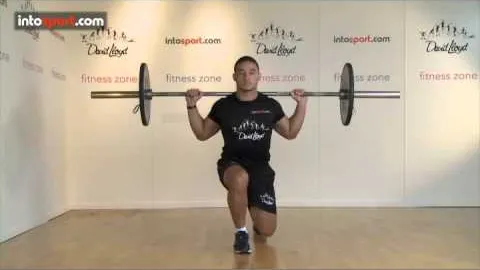
If you're looking to build strength and definition in your legs, the barbell lunge is an exercise you should definitely consider incorporating into your workout routine. This compound movement targets multiple muscles in your lower body, making it highly effective for building muscle and improving overall lower body strength. In this article, we will explore the benefits of the barbell lunge, proper form and technique, and how to include it in your training program.
Muscle Development: The barbell lunge primarily targets the quadriceps, hamstrings, glutes, and calves, making it a great exercise for building strength and muscle mass in your lower body. It also activates the core muscles to help stabilize the movement.
Functional Strength: The barbell lunge mimics movements we perform in everyday life, such as walking or climbing stairs. By strengthening the muscles involved in these movements, you improve your overall functional strength and make daily activities easier.
Improved Balance and Stability: Performing lunges with a barbell requires stability and balance, especially when using heavier weights. By practicing this exercise regularly, you enhance your balance and stability, which can be beneficial in various sports and activities.
Joint Flexibility: The dynamic nature of the barbell lunge helps improve joint mobility and flexibility in the hips, knees, and ankles. This can reduce the risk of injury and enhance overall athletic performance.
Calorie Burning: Since the barbell lunge activates multiple muscles and requires a significant amount of energy, it can help increase your calorie expenditure during the workout. This makes it a worthwhile exercise for those looking to burn fat and lose weight.
To perform the barbell lunge correctly and maximize its benefits, follow these steps:
Setup: Begin by placing a barbell across your upper back, resting it on your traps or shoulders. Make sure your feet are shoulder-width apart, with toes pointing forward.
Step Forward: Take a controlled step forward with your right leg, shifting your body weight onto the front foot. Bend both knees to lower your body into a lunge position.
Depth: Lower your body until your front thigh is parallel to the ground, keeping your chest lifted and core engaged. Your back knee should be hovering just above the ground.
Push Back: Push through your front heel to return to the starting position. Complete the desired number of repetitions before switching to the other leg.
Important tips to remember:
Now that you understand the benefits and proper technique of the barbell lunge, let's discuss how to include it in your training program.
Warm-up: Begin with a dynamic warm-up to prepare your muscles and joints for the exercise. Perform a series of bodyweight lunges, leg swings, and hip circles to increase blood flow and mobility.
Resistance Training: Include the barbell lunge in your leg day routine, aiming for 2-3 sets of 8-12 repetitions on each leg. Add additional weight gradually as you become more comfortable with the exercise.
Variations: To target different muscles and add variety to your workout, consider trying different lunge variations such as walking lunges, reverse lunges, or lateral lunges.
Progression: As you become stronger and more proficient, you can progress by incorporating more challenging variations or increasing the weight. Always prioritize proper form and technique over adding weight.
Recovery: After performing the barbell lunge, cool down with static stretching exercises to prevent muscle soreness and enhance recovery. Focus on stretching the quadriceps, hamstrings, and hip flexors.
The barbell lunge is a highly effective exercise for building leg strength, muscle mass, and functional fitness. By incorporating this compound movement into your training routine, you can reap a wide range of benefits, including improved muscle development, balance, joint flexibility, and calorie burning. Remember to maintain proper form and technique, gradually increase weights, and listen to your body's limitations. So, lace up your sneakers, grab the barbell, and start lunging your way to stronger, more powerful legs.
If you're looking for a gym, fitness club or yoga studio, you've come to the right place.
You can find information about gyms in your area. Browse catalog of gyms and find gyms with classes which are you looking for.
On gym page you can find simple information like address, phone or website. You can find list of available classes. You can check availability of personal training or small group classes. On place page you can also see information about open hours.
You can find gyms near you with amenities, courts, studios and equipments.
Use our map to find gym at your city or district.
In Gym Navigator you can find list of exercises with movies for many body parts.
You can browse exercises catalog and find exercises the best of you.
You can also find exercises grouped into workout plans, which you can use to improve you body. Each routine show you exercises one by one and give you possibility to count you progress and count down rest time.